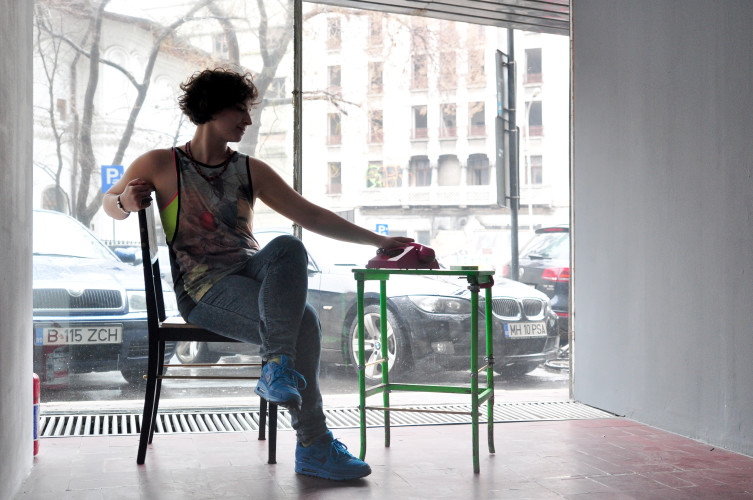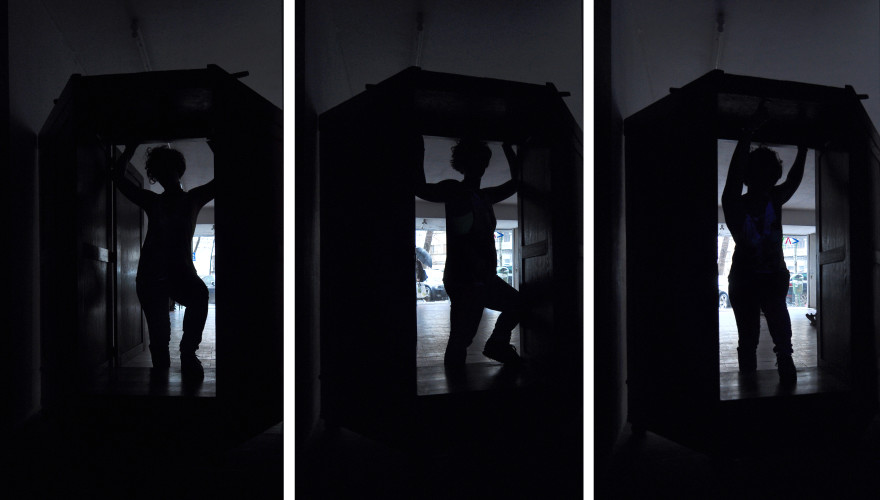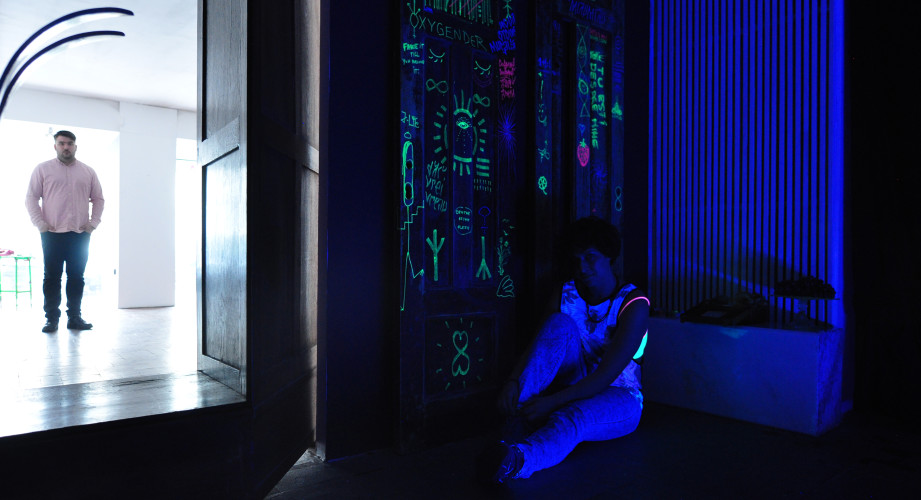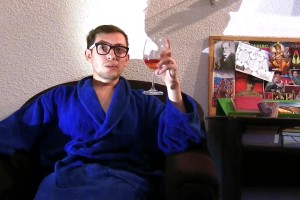The Center for Visual Arts hosted a one-on-one performance called “I live in the times of everyone” that lasted till the 30th of January. Using performance, Lala Mișosniky wanted to personify a house she was very attached to, as part of a bigger project that will continue to take various forms. Her body, in relation to a few objects and the spectator, stores the selective memory of a space, an archive sorted by years. I went to her performance on a Thursday at 2 PM. There was nobody there, the door was locked. Through the window I could see two coffee cups, a casserole with a small baklava with pistachio and a scarf on the chair. Lala soon showed up, she took a bathroom break. We jumped right in.
I sat on the chair and she started the routine by mirroring what I did with a welcome monologue. The simple act of imitating the other’s gestures, at firsthand, yet so odd, took place in a window display: the exposure of an ego construct in a white space with a street view. I felt an amplification of the ego and I identified with Lala’s strange character. The spectator’s narcissistic satisfaction during a one-on-one performance shouldn’t be overlooked or ignored. Lala knows how to spin the spectator’s perversity, whose favorite object is their own body, while the performer pushes you in the troubled waters of self-love, without making sure you know how to swim. Fortunately, Lala is at the edge of the pool with a conceptual stick that keeps you from drowning in the various forms of investing in a self-libido. Let’s not forget the basic element of narcissism: choosing the narcissistic object that is based on precisely the similarity between object and subject, something that Lala highlights with the format of the performative act. During a one-on-one, the spectator’s self-esteem grows due to the tendency of seeing their ego as a (false) point of reference, around which the whole experience is organized. The effect of this format, in my case, was remembering two episodes from the past: many years ago, while flying from Budapest to Vienna, I was surprised to find that I was the only passenger and the pilot and the entire crew addressed me directly by using my name when speaking on the plane’s mics and when performing the safety procedures; the second, more recent episode was about Farid Fairuz’s one-on-one 2015 performance for men, when I tried to be there, but then I got rejected on account of the fact that the event couldn’t work with people who already knew each other, which also had the same effect of absurdly boosting my self-worth and appreciation, even when denied a one-on-one performance or the chance to be one of the chosen ones. I think that this type of performance can be beneficial for people who suffered violent blows to their self-esteem early on in life, who compensated by building a grandiose image of themselves and who usually answer to any threat to their image with blind fury. I must add that these people are impossible to analyze from a therapeutic point of view, which makes this artistic initiative that much more praiseworthy for transforming the impossible into reality.
The construct of the performance uses efficient spatial counterweights: the house on Armoniei street (the old Prophet street, observe the contradiction!) with its entire story and the lack of character of the gallery, its industrial-white walls with the window facing the street where the event effectively takes space, the two playgrounds – the first is a white room facing the street and the second is a black armoire-coffin. The narrative fragments are also contradictory, same with the closeness-distance between the performer and the spectator, the fitness costume – the elegant outfits belonging to the evoked characters or the ideas grouped together in the synopsis – entropy / utopia, place / body, freedom / conventional, height / roots, exposure / intimacy, private space / project house.
What I liked about “I live in the times of everyone” was the fact that it was a raw performance. At first, I didn’t know that Lala was an actress and I considered the event to be a purely visual art project. It is a paradox that a lot of visual artists and choreographers, when performing, especially on stage, commit the most horrible acting clichés, that they often don’t think about and, instead, follow the instinct of “looking good” on stage, of trying to save a moment that the performer perceived as embarrassing. This is the same with amateur actors with no experience on stage, “they play around” for maximum effect, but their style of embodiment is only a rehearsal of a stage presence cliché that is too easily overlooked. That is, in case the performer doesn’t get stage fright during the performance, when he loses his diction, delivers his lines with inept grumbles and expresses only one thing with his moves: shyness. That wasn’t the case with Lala.
What only seems like an aesthetic entropy, a mess of objects, stories, spaces and emotions, becomes coherent and follows a pre-determined concept with the artist’s permanent intervention, which keeps all the elements in check, offering them meaning and absolute necessity in the set frame. The objects in use have a special role: these are those household objets trouvés, capable of offering satisfaction to the participants, the artist relates to them in order to direct her wish or action to multiple characters. The psychoanalytical confusion between the object (which is almost always a person) and object (the term usually used for inanimate things) is extremely well used in the performance: most of the time we have good objects, that the narrator loves, which she experienced as benevolent objects, no matter if they’re external or internal. The internal objects of the performance (the ones we don’t see but are reminded of) obtain the significance of the external objects we come in contact with. These internal objects are the ghosts from Armoniei Street, images presented to us as fantasies that come to life, become material. They have a strong connection with the external objects, but are ultimately things that have been lost, just like the house in question: it doesn’t exist anymore, it was demolished, left in disrepair, it was taken by middlemen, or it simply left a few marks which anticipate and triggers remembering using precisely the exterior objects, objects of mourning (like black clothing) which evoke the sadness of a loss. Speaking of the objects that were used in the performance, I couldn’t help but notice the indirect commentary on the status of the local performance artist: in the art of the spectacle, playing with “things you bought from home” is disgraceful, degrading, it translates into the lack of a minimal budget for production and implies the lack of acknowledgement, value and worth of a local artist. The expression itself has become a metaphor for an art work done hastily. Lala Mișosniky completely flips this negative meaning and makes a performance using things she has “around the house”.
The house as a lost object, although not necessarily the actual loss of the building, has been permanently stated at the Center for Visual Arts as: a profound feeling of dislocation, sinister, disappearance of an entire world (best illustrated with the usage of the antique rowing device, which made you think of people who lose their houses during floods and who have to row for their lives). The objects I was talking about earlier are the signs of an emotional wreck, pieces thrown away by waves of selectivity, or a series of things that people who have been evicted have on hand (usually these are object with no real value, but that mean a lot to them on an emotional level), especially those who are forced to abandon the houses they were born in or lived in for 30-40 years due to retrocession. In “I live in the times of everyone” there is a strong feeling of dislocation and alterity, no matter where the narrator sets the space and time, a profound lack of a legitimate place, an enactment of the concept / play on juifemme words that Hélène Cixous uses to describe herself, words that capture homelessness and hybridity, something the Lala thinks about as well: the thought of luck and bad luck, chance, immigration and exile. For Cixous, the arbitrary multiplicity of the self, the experience of finding your place everywhere and nowhere, the statelessness and lack of a fixed identity become sources of creativity for fabricating your own country, a home away from home. Giving up your parents’ house, your grandparents’ house, the place you spent your teen years, this dislocation is, in a paradoxical way, a generative space of new meanings for juifemme.
Jacques Lacan is the one who explains the interior otherness in the house of subjectivity, growing farther apart from your childhood home, like a manifestation through and with language, like a something you said that came out wrong, a failure, like forgetting the name or the details of something relevant. And when this interior otherness manifests itself, it pokes holes in the subject and its world, indicating the illusory nature of the subject. The unconscious makes its way into the conscious existence and exposes the subject’s emptiness, its lack of stability or permanency, the fact that it is unfinished and fragmented, that important pieces of the puzzle are missing. “I live in the times of everyone” plays with all of these and exposes the unconscious within the concrete discourse, exactly what is not at hand for the subject to remake the continuity of a discourse of clarity and coherence. Relationships that are strictly linked to private property are a crucial element in the rooted ideological system of subjectivity and the only model capable of re-configuring it is a model based on jouissance: the crumbling of the self that can offer the erotic possibility of a positive canceling out of private property at a subjective level, by giving up the property in Armonei Street as a means of searching for the abject (Leo Bersani), by giving away all possessions, including the intellectual ones, but also by giving up the attributes that make up the self as a valuable property.
The answer to the eminently modern experience of being dislocated and of feeling like your subjectivity as well as your house are slipping through your fingers is neither nostalgia for something that has disappeared for good, nor is it a game with no limits and nowhere to hide. When the crisis of signification shows up, there are other possible answers. Although “I live in the times of everyone” fancies with both these easy solutions (a melancholic and filled with regret nostalgia for origins, a desire towards an archaic innocence in which trying to interpret is just another form of self-eviction or, on the other hand, an exuberant asserting of a game in a world without a center, safety, protective walls or a foundation), presenting the catastrophe isn’t followed by a big revelation and the two possible answers are not strictly confined. What I can only admire and find as the true overcoming of any expectations from this performance is the discovery that the revelation after the catastrophe does not exist, but it is still expected, it opens the world and the house (as Lala knew or thought she knew them), the revelation is self-proclaimed as missing, but still awaited. This way, we are truly dealing with Episode 1 – Pilot, a work in progress, a beginning without knowing what comes next.
I live in the times of everyone / Armoniei Street – Episode 1 – pilot / The personification of the house / Work in progress, a performance by Lala Mişosniky, Multimedia Center for Visual Arts, 16 Biserica Enei Street, Bucharest 19-31 of January 2016.
POSTED BY
Mihai Lukács
Mihai Lukacs (b. 1980) is a stage director, performer, theorist. Lukacs holds a PhD in comparative gender studies from Central European University Budapest with a thesis on the male hysteria of the m...





Comments are closed here.